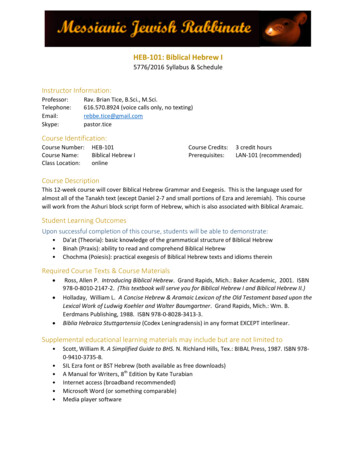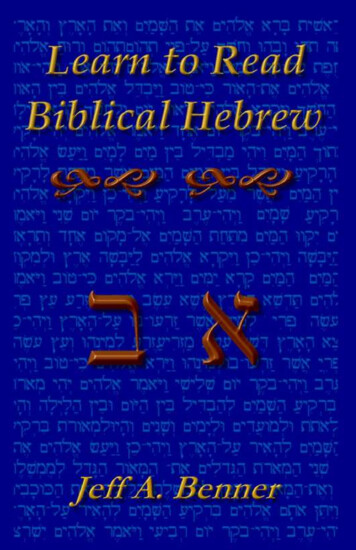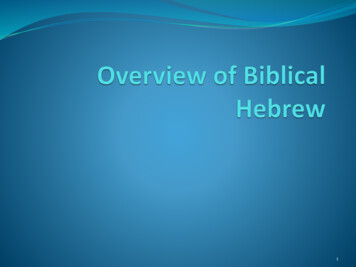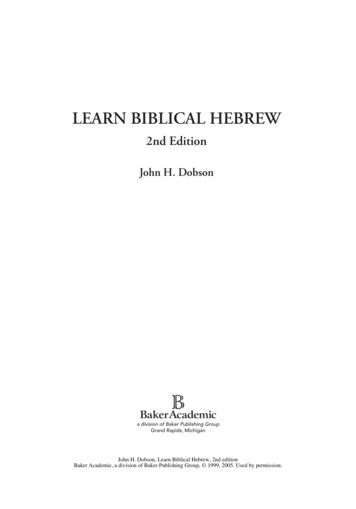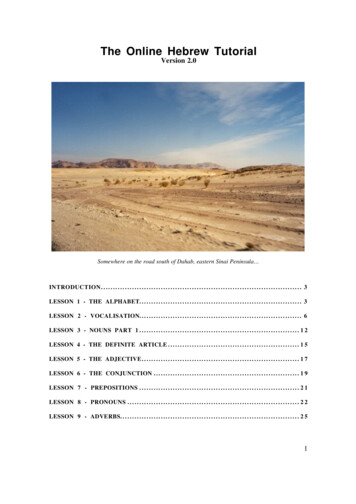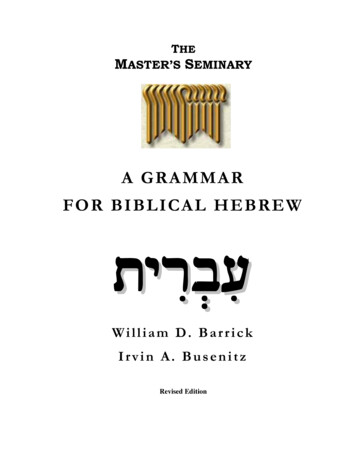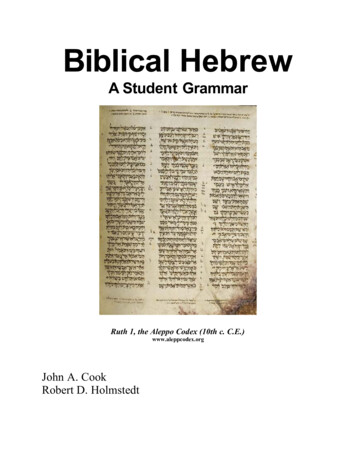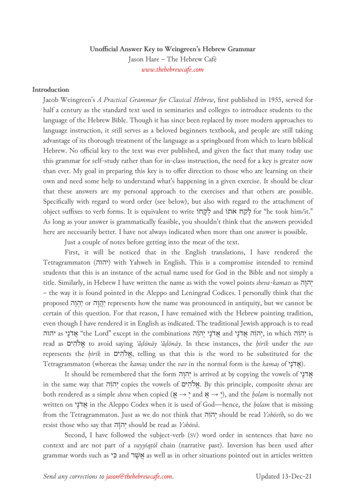![A GRAMMAR FOR BIBLICAL HEBREW TyrIb][i - DrBarrick](/img/22/b-b-hebrew-grammar-wkbk-full.jpg)
Transcription
THEMASTER’S SEMINARYWORKBOOK FORA GRAMMARFOR BIBLICAL HEBREWtyrIb][iWilliam D. BarrickIrvin A. BusenitzRevised July 2004
2Barrick & Busenitz, A Grammar for Biblical Hebrew – Workbook
Barrick & Busenitz, A Grammar for Biblical Hebrew – WorkbookName.Box #EXERCISE 1Introduction to the Hebrew LanguageAlphabetA.Explain the importance of studying biblical Hebrew.B.What is the origin of the term Semitic?C.Briefly describe the five main branches of Semitic languages.1.2.3.4.5.3.
Barrick & Busenitz, A Grammar for Biblical Hebrew – Workbook4D.Write the alphabet five times in the spaces provided below. Follow theseguidelines: For each of the 22 Hebrew letters exactly as written in the boxes in Chapter 1of the textbook.Repeat aloud the name of each letter as you write ze the alphabet. (Note: Some students find it helpful to memorize it insegments of 4 letters each.)5
Barrick & Busenitz, A Grammar for Biblical Hebrew – WorkbookF.5Which letters sometimes have a dot called dagesh? (Write the Hebrew lettersthemselves, not their names.).G.Which letters have a different form when they occur at the end of a word? (Writethe Hebrew letters.).H.Which letters (both regular and final) extend either above or below the line ofwriting? (Write the Hebrew letters.).I.Distinguish carefully between the letters which have similar forms. Copy theseletters carefully in the spaces provided below.b and kg and nd and rd and h and jw and zw and @! and s! and f[ and x[ and v and .Circle one letter in each group that has some major difference with the remainingletters. Describe the difference.1.t n m kDifference:2. l qDifference:3.x # !Difference:
6Barrick & Busenitz, A Grammar for Biblical Hebrew – Workbook
Barrick & Busenitz, A Grammar for Biblical Hebrew – WorkbookName.Box #EXERCISE 2Alphabet - VowelsA.Which vowels are known as full-letter vowels?.Why are they called full-letter vowels?B.Circle the item in each group which does not belong and explain why.1.(W)(/)( y i) ( E )Reason:2.( ")(u)( )( E)Reason:3.(W)(/)( y )e ( I )Reason:4.( O)( I)Reason:( y e) ( W )7.
Barrick & Busenitz, A Grammar for Biblical Hebrew – Workbook8C.Read the following exercise aloud. Be sure to pronounce the vowels correctly.The sign ( Ë) placed above a letter indicates the accent is on that syllable. All otherwords are accented on the last syllable.1.Long vowels:Wy yfe Wz w: r: qo WP yKe D: Be ymi G: yDID: GO WT yKe b; yrI s; yxi po te n: /l yji2.Short vowels:K' c' f, z" w" xu qi T, P' s, fu DI Bi h' P,nI hu a, wI [, j' G b, r" T' DU mu nI l'3.Long and short vowels:yvi /B DE f, G" WT zU w r" qo P, yKe DE b' ymiyyE Wf ynE yj' GI be yPi Wy /t yrI G fu yxi c'4.Words with one syllable:dnE !yPi vyji @G" ljo rWP l/m ba; #f' rDo Wr ryvi r/a l/q b/f lyGI sWs !ai dyae vyE5.Words with two syllables:r['n"Ë br [,Ë rq,BoË rp,seË vm,v,Ë lfeqo rBeDI rb;D:ynIyBe [r"z Ë dr w Ë Wlj; &WrB; aseKi rmevo lk'a;rm'a; @b,a,Ë yliae @yIy"Ë l['B'Ë rj'yI rz [eË yhiywI hr:q;
Barrick & Busenitz, A Grammar for Biblical Hebrew – WorkbookName9.Box #.EXERCISE 3Alphabet - Special Letters, Dagesh, and RapheA.Which letters are true gutturals? (alphabetical order, right to left).Which letter sometimes behaves as a guttural?B.What are the three characteristics governing the gutturals?1.2.3.C.Identify the strong gutturals:.Identify the weak gutturals:.Which letters of the Hebrew alphabet sometimes lose their consonantal characterand become silent? Write them in alphabetical order from right to left.D.Which letters are labials?.Why are they called labials?E.Identify the two different kinds of dagesh:andF.Which letters take the weak dagesh? (alphabetical order, right to left).How does the weak dagesh affect the pronunciation of these letters?.
Barrick & Busenitz, A Grammar for Biblical Hebrew – Workbook10G.H.When is the weak dagesh omitted from one of these letters?1.2.What letters accept the strong dagesh?What effect does the strong dagesh have on these letters?I.Why is the strong dagesh most commonly employed?1.2.J.Describe the functions of the raphe.K.Circle the letter that does not belong in each group and explain why:1.[ j p h aReason:2.y w j h aReason:3.p m d bReason:4.j h aReason:5.r [ j h aReason:6.y w h aReason:7.k l d bReason:8.t p n kReason:L.On the reverse of this page, complete 7A on page 33 of the textbook.M.Also on the reverse of this page, perform the exercise described in 8A on page33 of the textbook.
Barrick & Busenitz, A Grammar for Biblical Hebrew – WorkbookN.Translate the following Hebrew q'l;11
12Barrick & Busenitz, A Grammar for Biblical Hebrew – Workbook
Barrick & Busenitz, A Grammar for Biblical Hebrew – Workbook13Name.Box #.EXERCISE 4Alphabet - Half Vowelsand SyllablesA.Indicate whether each of the following statements is True or False by circling eitherT or F.If the answer is False, give the correct answer or edit the sentence tomake it read correctly.Example: When two shewas occur back-to-back in the middle of a word, the first issilentvocalalways vocal and the second is always silent.T F1.When two shewas occur back-to-back in the middle of a word, the first isalways vocal and the second is always silent.T F2.The shewa is not a regular vowel.3.When two shewas occur back-to-back at the end of a word, the first is silentand the second is vocal.T F4.A shewa which follows a full-letter vowel is usually silent.T F5.A shewa placed under a letter with a dagesh forte is vocal.T F6.The vowels are always pronounced after the consonant with which they areplaced.T F7.Words always begin with a consonant and not with a vowel.T F8.The always takes a vocal shewa when it stands vowelless.T F9.Shewas which begin syllables are vocal; shewas which close syllables aresilent.T F10.The gutturals and r require a composite shewa where other letters would onlyrequire a simple shewa.T FT F
Barrick & Busenitz, A Grammar for Biblical Hebrew – Workbook14B.Circle all silent shewas in the following words:t/yb;n“ W[GIp]hi &mev] WhdEM]l'y“ !k,T]v]B; T]r“m'a; qr"q ]r"y“C.Circle all vocal shewas in the following words:t/yb;n“ &mev] WhdEM]l'y“ !k,T]v]B; T]r“m'a; qr"q]r"y“ Whlep]ylia D.Divide the following words into /d:a}/h;!d:/a:rmo/v]lihr:Wgm] r/gm; [g"P; br:[}m' qr"q]r"y“(1)Wrm;Ëv; !ybik;/K !yIl'b]DI T]r“m'a;(2)Wnmef]c]yI !yhiløa @WxB;r“yI !yIm'Ëv;(3)Read aloud the following exercises. Be sure to pronounce the vowels correctly. Thesign ( Ë) placed above a letter indicates that the accent is on that syllable. All otherwords are accented on the last syllable.1.Words employing the shewa and furtive pathach:!yrIm]/v &WrB] ['/mv] j'Wr ['/ml] rmov]li rmol]!yhiløa T]r“m'v; &l,m,Ë hm;d:a} Wrm]v]yI WlF]qi&/T /Br“j' @k,K]l]m' T]l]f'q; lkoa} !ymik;j} rbo[}rpesow“ ynEp]li l['p]nI yrEj'a} rmov]a, !/loj} &l,m,Ëw“2.Words with letters that look alike:k and b(a)b/f d/bK; hKo bk;/K ar:B; jf'B; zz"B;dbeK; aSeKi rq,BoË br [,Ë lkoy: lk;yhe rb'[; lk'a;
Barrick & Busenitz, A Grammar for Biblical Hebrew – Workbook15g and n(b)hl;G: @G:h' vg"n: #g"n: [g"n: an: bn"G: !G" ld"G:lm;G: vgEnO gG" lp'n: @t'n: @G" vgEN:yI !yNIG"d and r(c)[v;r: !Wr #d"r: br" r/D dwID: varo rb;D:/Td“rI !D"r“nI hd ro vr"D: rd aeË r/rD“ &r D Ë !D:j and h(d)rh;n: rh' gr"h: hf;j; &v,joË qz"j; @he &l'h; hy:j;!henO hj;n: hw:q; lh;q; vj;n: lj'n: jq'l; @heKow and z(e)dl;y: rz"w: rk'z: bh;z: sWsw“ tazO zz"B; zWB[r"z Ë hZ h' h[or“p'W !d:a;w“ hn:b;W ynIv]w" @qez:! and s(f)!yMiy" sWn #s,K,Ë #s'y: ds,j,Ë !l'j; aSeKi !/y sWs!d:a; #s,ao #s'a; bb's; rp's; !ve !Wq !k;j; !['c and v(g)[v;r: #r"c; hr:c; !yci !v; rb'v; la'v;vgEnO rc;B; lv'm; ac;n: vp,n Ë hc;[; fpevo vm,v,Ë
16Barrick & Busenitz, A Grammar for Biblical Hebrew – Workbook
Barrick & Busenitz, A Grammar for Biblical Hebrew – Workbook17Name.Box #.EXERCISE 5Accents and Review of SyllablesA.B.Briefly describe the function of the following accents:1.Athnach2.Silluq3.Soph pasuq4.Zaqeph qaton5.MunachDivide the following words into syllables by drawing a vertical line between hm;/d:a}/h;!d:/a:rmo/v]lilkoy: ar:B; &l,m,Ë lf'q; rm'v; lkoa} &WrB; d/bK; br [,Ë(1)!k,T]v]B; tr m,Ëvo !ybik;/K !yhiløa hm;d:a} T]r“m'v; T;r“m'a;(2)Wnyker:d“Ki !l;/[l]h' !k,ylea} !k,yte/ba} rmoale hy:k]c:ê(3)Indicate whether the following : vowels are qamets or qamets hatuph by circlingthe correct answer. Clue: Qamets hatuph is located in a closed and unaccentedsyllable.1.rm'a;2.hl;k]a;âfirst vowelsecond vowelqametsqamets hatuphqametsqametsqamets hatuphqamets hatuph
Barrick & Busenitz, A Grammar for Biblical Hebrew – Workbook18D.3.hm;k]j;first vowelsecond vowelqametsqametsqamets hatuphqamets hatuph4.T;r“m'v;first vowelsecond vowelqametsqametsqamets hatuphqamets hatuph5.hK;r“a;first vowelsecond vowelqametsqametsqamets hatuphqamets hatuph6.Wrz“[:âqametsqamets hatuph7.!h,ynEz“a;qametsqamets hatuph8.hn:v;qametsqametsqamets hatuphqamets hatuph9.ynINEj;qametsqamets hatuphfirst vowelsecond vowelIndicate whether the statement is True or False by circling either T or F.If the answer is False, correct the statement.1.Closed syllables may end in a consonant.2.Normally, long vowels occur in open syllables and short vowels occur inclosed syllables.T F3.Syllables which are closed and have no accent must have a short vowel.T F4.Long vowels do not occur in closed syllables.T F5.Short vowels do not occur in open syllables.T F6.Hebrew words can take their primary accent on the last two syllables butnever on any other syllable.T F7.The metheg differs from the silluq in that the metheg occurs only under thetone syllable of the last word of the verse or phrase.T FT F
Barrick & Busenitz, A Grammar for Biblical Hebrew – Workbook198.If the vowelhatuph.:occurs in a closed, unaccented syllable, then it is a qametsT F9.If the vowel:occurs in an open, accented syllable, then it is a qamets.T F10.The silluq designates the principal division of the verse but does notnecessarily divide it in the exact center.T FE.Define what it means for Hebrew words to be in pause.F.Transliterate the following Hebrew words. For the vowels use the transliterationsymbols given in the vowel chart in the textbook on page 39. For the consonantsuse the transliteration symbols given in the chart on pages 20-21 in the textbook.Divide the syllables by using hyphens.Example:a l)-h'm !yhiløa rk;z:rB;d“mi r �a;
20Barrick & Busenitz, A Grammar for Biblical Hebrew – Workbook
Barrick & Busenitz, A Grammar for Biblical Hebrew – Workbook21Name.Box #.EXERCISE 6The Article and InterrogationA.Attach the definite article with the appropriate pointing to the following words. Br/kB]bh;z:[r"z ËbyEaodl,y Ë@G"r/arp;[;br Ktm,a Ë&v,joË@yI['Ëbb;leqjo*lw [;Ërh;n:&r D he!/y!k;j;lg r Ë!j,l,Ëqz:j;!yIm'Ëv;Attach the interrogative h with the appropriate pointing to the following words. 'af;j;q['x;11.12.13.14.15.ynIa}hn:[;ayhidl'y:&l'h;
Barrick & Busenitz, A Grammar for Biblical Hebrew – Workbook22C.Attach the interrogative hm with the appropriate pointing to the following c;[;hL,aeËaWhhz YIAhm'11.12.13.14.15.[g"n:rk'm;lg rË rm'ao&p'v;Circle the article in each group which is pointed incorrectly and explain why. [10]1.!d:a;h, ![;h; rb,Q,Ëh'Reason:2.@/ra;h; dl,y Ëh, r/Dh'Reason:3.lk;yHeh' lWbG“h' @yI['Ëh;Reason:4.ry[ih; !aeh; ja;h'Reason:5.rq;B;h; !l;/[h; vWkr“h:âReason:Circle the interrogative h in each group which is pointed incorrectly and explainwhy. [10]1.yrIa}h; aløh} lf'q;h}Reason:2.hl;[;h, T]a'h' rm'V;h'Reason:3.rmeaoh; @T,[]d"y“h' lvom]yIh}Reason:4.!l'j;h' &l'm;h} lf'q;h}Reason:
Barrick & Busenitz, A Grammar for Biblical Hebrew – Workbook5.F.Reason:Indicate whether the statement is True or False by circling either T or F.If the answer is False, correct the statement. [10]1.G.hn b]yIh} hm;d:a}h; rm,atoh}23Though usually attached, when the definite article stands alone(unattached), it has the form lh'.T F2.When the article is attached to a word beginning with a guttural, it ispointed with a qamets.T F3.Like the article, the interrogative h is pointed with a pathach when it isaffixed to a word beginning with a guttural.T F4.The interrogative h is always attached inseparably.5.The interrogative pronouns ymi and hm follow basically the same pointingas the article.T FT FTranslate the following words into English. [30]the man!d:a;h;@Beh'y/Gvyaih;dY:h'hV;aija;h;&r D Ëh'!/Yh'rb;D:man, a man!d:a;@Bey/Gh'vyaidy:hV;aih;ja;&r D Ë!/yrb;D:h'12345678910
24Barrick & Busenitz, A Grammar for Biblical Hebrew – Workbook
Barrick & Busenitz, A Grammar for Biblical Hebrew – Workbook25Name.Box #EXERCISE 7PrepositionsA.Attach the preposition l inseparably to the following words. lm;G:tazOl]6.7.8.9.10.rc;B;bk;/Ktm,a ;qz:j;!yIm'Ëv;Attach both the inseparable preposition l and the definite article to the followingwords. ,q,Ërb;D:ry[i@r q,Ërq,BoËrc;B;r/Dlk;yhelg r ;/[vWkr“hl;k]a;&l,m,Ër/a!/ytm,a iløa hm;d:a}!yIm'Ëv;lh;q;sWs!ve@G"r/rD“varo.
26Barrick & Busenitz, A Grammar for Biblical Hebrew – WorkbookC.Attach the preposition @mi inseparably to the following words. aoqr:B;mi11.12.13.14.15.lg r Ëvj;n:taZoh'hm;d:a}lk;yheThe following words have a preposition prefixed to them. Indicate whether theyhave the article (articular) or do not have the article (anarthrous). If the wordis articular, give the anarthrous form with the preposition; if it is anarthrous, givethe articular form with the preposition. [10]Examples: E.rb;d:K]lk;yheB'( articular; x anarthrous) rb;D:K'( x articular; anarthrous) lk;yheB]1.!/da B,( articular; anarthrous)2.!d:a;K:â( articular; anarthrous)3.taF;j'me( articular; anarthrous)4.t/c[}l"â( articular; anarthrous)5.vyail;( articular; anarthrous)Circle the one inseparable preposition which is pointed incorrectly in each set andexplain why. [10]Example:rv,a}K' hd:WhyBi vyail'Reason: Before a guttural the pathach becomes qametsfor the definite article.1.hm;d:a}li lk;yheB] !d:a;K:âReason:2.lgEr"me hd:Why“li l/qB]Reason:3.!/da K, !yhiløa B, !d:a;K:âReason:
Barrick & Busenitz, A Grammar for Biblical Hebrew – WorkbookF.4.vyaimi hl;y“L'ËB' rp:[;K,Reason:5.!j,L,Ël' vj;n:mi !d:a:h:âmeReason:27Translate the following words and phrases into English. [100]Example:.a man!d:a;l:ây/Gh'me!/YK'tyIB'Ëh'meba;K;tyIB'Ë rj'a'Ë!yhiløaleyj' yliB]!d:a;h:â ![ivyaifor the manvyail;!d:a;l]y/Gmi!/yK]tyIB'Ëmiba;K]ja; rj'a'Ë!yhiløa la,vyaih; @yBerb;D:h' tae!yhiløa ynEp]li !d:a;K:â@heKoh' !d:a;h:â ha;r:hc;[;Ahm, @Beh' rm'a;!d:a;l:â !yIm'Ë @t'n: ymilk;yheh'A@mi ![;l; &l,M,Ëh' rB,dIh} r a:âB; rh;h; !yhiløa !yci![;l; r aË;h; !yhiløa @t'n:rh;l; lk;yheh"âme @heKoh' ax;y: (1(2(3(4(5(6(7(8(9(10(11(12(13(14(15(16(17
28Barrick & Busenitz, A Grammar for Biblical Hebrew – Workbook
Barrick & Busenitz, A Grammar for Biblical Hebrew – Workbook29Name.Box #EXERCISE 8Conjunctions and the Relative PronounA.Attach the conjunction w with the appropriate pointing to the following words. yrIB]@G"tazOw“6.7.8.9.10.bb;leha;r:lg r Ëqjor/Bqr:B;W11.12.13.14.15.dl,y Ëhj;n“midg B,ËlWbG“tm,a Circle the conjunction in each group which is pointed incorrectly and explainwhy. [10]Example:rv,a}w" hd:WhywI vyaiw:Reason: The conjunction in situationsother than before shewa, labials, composite shewas, or pause, takesa shewa.1.!d:a;w“ !yrIb;d“W @bew“Reason:2.&l'h;w“ rk'm;w“ ry[iw“Reason:3.rb;d:W bh;z:w“ js'p,'ËWReason:4.rc;b;w“ br q Ëw“ hp,WReason:5.!l;/[w“ ar:b;W @['n"Ëk]wIReason:.
Barrick & Busenitz, A Grammar for Biblical Hebrew – Workbook30C.Circle either T or F in order to indicate whether the statement is True or False. Ifthe statement is False, give the correct answer. [10]1.Originally the conjunction w was pointed with a pathach and followed by adagesh forte, similar to the definite article.T F2.Like the inseparable preposition, the pointing under the conjunction ischanged to a hireq when it is attached to a word beginning with a simpleshewa.TFWhen the conjunction is a W, then the first letter of the word to which it isattached must be a b, m, p, or a letter with a simple shewa.TFWhen the conjunction is attached to a word beginning with a compositeshewa, it is a shureq.TF3.4.5.D.Like the inseparable prepositions, the conjunction, when attached to a wordbeginning with the definite article, does not take the position and pointing ofthe article.T FTranslate the following words and phrases into English. â:w“@beWhV;aIh;w“ vyaih;ja;h;meW ba;h;me @Bel'lk;yheh'Ala, &l,M,Ëh' 1 aB; hl;y“L'Ëb'W(1hV;aIh;w“ vyaih; !yhiløa hc;[;(7!yhiløa h:â rj'a'Ë y/Gh' &l'h; &l,m,Ë yliB](8aB; is a form of the verb a/B (to come, to enter). It may be translated as he came or he entered.(2(3(4(5(6
Barrick & Busenitz, A Grammar for Biblical Hebrew – Workbook31ry[ih;me aB; rv,a} vyaih; 1 tae &r D ËB" @heKoh' &l'h;E.(9hl;y“L'ËB' ry[ih; l[' 2 ![;h; aB;(10rB,DI rv,a} rb;D:h' rv,a}K"â y/Gl' !yhiløa @t'n: rv,a} r a:Ëh : ![;h; ha;r:(11rh;B; tB'h'w“ @Beh' tae vyaih; bv'y:(12Translate the following words and phrases into Hebrew. [25]Example:The woman in the palacelk;yheb' hV;aih;1. The king and the servant2. Between the son and the daughter3. Before God and the king4. According to the master5. From the water to the water1See the textbook, page 60, footnotes 95 and 96, concerning tae as either a preposition or the direct objectmarker.2With regard to this form, see the textbook, page 53 (5C).
32Barrick & Busenitz, A Grammar for Biblical Hebrew – Workbook
Barrick & Busenitz, A Grammar for Biblical Hebrew – Workbook33Name.Box #.EXERCISE 9Noun and Adjective: Their Gender and NumberIn the chart below, observe the general vowel changes that usually take place informing a masculine plural noun or adjective. Note that some words are bothadjectives and nouns (e.g., !k;j; wise man as well as wise). The followingexamples do not cover all possible vowel changes in Hebrew nouns of one or twosyllables.1-syllable nouns2-syllable nounsA.SingularPlural!D: D“!ymik;j}!yli/dG“!yaiycin“Give the masculine plural of the following words. [10]Singular lar6.7.8.9.10.rq;B;rP;rWsll;j;bz:K;Plural
Barrick & Busenitz, A Grammar for Biblical Hebrew – Workbook34B.C.Review the chart in the Textbook on page 69. Give the feminine singular and pluralof the following words (5):Masculine SingularFeminine SingularFeminine PluralsWsb/fl/dG:!k;j;vdEq;r/hf;hs;Wst/sWsCircle the incorrect word and explain why it is incorrect (5):Example:D.hs;Ws hb;/f hv;yaiReason: should be hV;ai1.t/sWs !ynIz“ao !ysiWsReason:2.ts;Ws hl;/dG“ hb;/fReason:3.!yrIb;D“ mysiWs !yhiløa Reason:4.hb;/f hV;ai hm;k;j;Reason:5.t/l/q t/Vai t/b/fReason:Translate the following Hebrew into English (5):{yisUSah (1 Kings 10:28)hflod:g (Genesis 20:9){yi ænA)fhºw (Genesis 46:32){yirfb:DaK (Genesis 24:28)
Barrick & Busenitz, A Grammar for Biblical Hebrew – Workbook35Name.Box #.EXERCISE 10Noun and Adjective: Their RelationshipA.1. Translate the following Hebrew phrases and sentences into smooth English. [75]2. Circle all attributive adjectives. [8]3. Draw a box around all predicative adjectives. [5]Note: Even though these phrases and sentences might be taken from the OldTestament (as indicated by the footnotes), do not use a Bible translation to help intranslating them.Example:the big horse is goodl/dG:h' sWSh' b/fsUØSaK sUØsºw (11rÙfB:diMaB sUÛSaK (223;h flod:Gah ryÛi(fh (345lOídfGah û}"hoKahºw (4ühfbO jerÜe)-le) (56lOêdfG yOØg-yim (6781hÕfwhºy lOØdfG (7;r fbfDah bOÛ 9[rèamf)] {Öf(fh (81 Kings 20:25Isaiah 63:133Genesis 10:124Leviticus 21:105Exodus 3:86Deuteronomy 4:77Psalm 135:581 Kings 18:249The word in square brackets has been altered from its form in this passage in the Old Testament in orderto make it translatable for the beginning student. The brackets should be omitted in the English translation.2
Barrick & Busenitz, A Grammar for Biblical Hebrew – Workbook361bOÕ :B (Øar-O) (Ùfr:B bOÛ 2qyÕiDacºw hØfwhºy 3 }UØNax (1045B.1Translate the following English phrases and sentences into Hebrew [31]:the great kingl/dG:h' &l,M,‡h'1.a good man2.good men3.good women4.a good woman5.The priest is good.6.The king and the nation are great.7.The people loved the good king from that great city.Leviticus 27:10Psalm 116:53gracious4Proverbs 17:265This sentence is not from the Old Testament, but reflects its concepts.2bOÕ -)ol qyØiDaCal (11.laer:c]yIl] !yhiløa hc;[; rv,a} !ybi/Fh'w“ !yli/dG“h' !yrIb;D “h' y/Gh' ha;r:Example:(9(12
Barrick & Busenitz, A Grammar for Biblical Hebrew – Workbook37Name.Box #.EXERCISE 11The Construct StateSupplementary Table of Construct E[;1See, also, the tables on pages 82 and 83 of the Textbook.A.Translate the following Hebrew phrases and sentences into smooth English.Note: Even though these phrases and sentences might be taken from the OldTestament (as indicated by the footnotes), do not use a Bible translation to help intranslating them.Example:He called on the name of God.2!yhiløa A!v,B] ar:q;{OÕh:t yØ"n:P-la( e Ùoxºw (131{ðfYah tíag:d (2Some of the nouns expressing family relationships take the hireq of the old genitive ending in theconstruct (e.g., ba; and ja;).2Genesis 1:23Genesis 1:26
Barrick & Busenitz, A Grammar for Biblical Hebrew – Workbook3812{Ùf hf&Ûf(-re A) axê"BºziMah ü{Oq:m-le) (434B.Rewrite the following words in their construct form. If the word is singular, give thesingular construct; if plural, the plural construct:rb'D“ te the following phrases into Hebrew:1.The house of the king:2.The man of God:3.The son of God:4.The words of the priest:5.The mares of the daughter:6.The name of the city:7.All of the nations:8.The brother of the woman:Genesis 8:5Genesis 13:43Genesis 14:124Nehemiah 10:295Ul:D:béN “they separated themselves” from *ladfB (he separated).2{Ùfr:ba) yÛixA)-}eB (5{yêiholE)fh tØarOT-le) ütOcfrA)fh yÜ"Ma("m 5 [Ul:D:béN] (6Example:C.{y irfhÒeh yÛ" )fr (3lKo!k;j;!yId"Ëy:@Bel/dG:1)2)3)4)5)
Barrick & Busenitz, A Grammar for Biblical Hebrew – WorkbookD.E.9.The hands of the good servant:10.The cities of the great land:39Circle the construct form in each group which is pointed incorrectly and explainwhy.1.vyai lKo dy"Reason:2.!ve ja' rb'D“Reason:3.![; yrEb]DI t/l/qReason:4.rh; ts"Ws ry[iReason:5.yrEb'D“ tr"/T @B,Reason:Indicate whether the statement is True or False. If the answer is False, edit thestatement so that it is worded correctly.1.Words bound together by a maqqeph are essentially considered one word, butare not always in a construct relation.T F2.Each noun in construct loses its accent and its long vowel.3.Normally, full-letter vowels cannot be reduced; however, occasionally theyare shortened when they occur in a noun in construct.T F4.The noun in construct is normally translated in a way that joins two nouns inthe construct relation with the English preposition “of.”T F5.In the Hebrew Bible the construct is always attached to the absolute (genitive)with a maqqeph.T F6.When the word in the absolute (genitive) is definite, the word in the constructalso has the article written with it in Hebrew, since they must agree. T F7.When an adjective qualifies a word in construct, the adjective is attached witha maqqeph and inserted between the construct and the absolute.T FT F
Barrick & Busenitz, A Grammar for Biblical Hebrew – Workbook408.When a word with a dual ending is in construct, the pointing is identical to aplural masculine noun in construct.T F
Barrick & Busenitz, A Grammar for Biblical Hebrew – Workbook41Name.Box #.EXERCISE 12Personal PronounsA.Translate the following Hebrew phrases and sentences into smooth English.Note: Even though these phrases and sentences might be taken from the OldTestament (as indicated by the footnotes), do not use a Bible translation to help intranslating them.Example: You are a good/beautiful woman.12T]a' hb;/f hV;airUÕ a) )Øfcæy )wÙihah jerÛf)fh-}im (1jerÕf)fh-lfK tØap:& hÙfwhºy lÛalfB {Öf -yiK lêebfB [ryi(fh] )Üf rfq }î"K-la( (23rêfKiKah yØ"rf(:B üba æy Oèlºw }a(Õfn:K-jer e):B bØa æy {Ùfr:ba) (34bOÕ )wÙihah jerÛf)fh bÖahÁz U (4561Genesis 10:11Genesis 11:93Genesis 13:124Genesis 2:125Genesis 17:16Genesis 26:292yêaDa lØ")-yénA) (5;h fwhºy UÛr:B hÙfTa( hÛfTa) (6
42Barrick & Busenitz, A Grammar for Biblical Hebrew – Workbook1;Un:x fnA) }Ùfrfx"m Ö {ÕeTa) }éyØa)"m (723;{ " ah yÛ" ºna) {ÙflO("m rÛe A) {yÖiroBiGah hfMÓ"h (94B.:TÜa)-y im Ö )UÙh yÖikïnf) yÓikïnf) (8;hæN "h heLÙ")fh-{éyO Gah yÛ"rf("m-)ol rÖe A) (10Translate the following sentences into Hebrew:The man who dwelt in the great city is good.The prophet saw all which God did to the great nation.The king took all of the things in this great city.The servant heard all the words which Abraham spoke to the kings of the land.God spoke to the man whom He created.1Genesis 29:4Isaiah 51:123Genesis 6:44Deuteronomy 20:152
Barrick & Busenitz, A Grammar for Biblical Hebrew – Workbook43HEBREW CROSSWORD 430DOWN1. lord, master2. head3. prophets4. brother6. between7. He created10. blood14. tent15. He blessed16. life, soul17. He loved19. one (m)232921.24.26.28.He sawHe knewHe tookdayACROSS1. He said3. He lifted up5. heart8. life9. He descended11. heavens12. utterance13. hand14. father16. prophet18. mountain19. mother20. from the king21. head22. man23. He was25. great27. nation29. toward the city30. peopleNOTE: Omit all vowelpointings. Final formsmust fit both directions.
44Barrick & Busenitz, A Grammar for Biblical Hebrew – Workbook
Barrick & Busenitz, A Grammar for Biblical Hebrew – Workbook45Name.Box #.EXERCISE 13The Regular Verb — PerfectA.Translate the following Hebrew sentences into smooth English. Assume that all ofthem are complete sentences.Note: Even though these phrases and sentences might be taken from the OldTestament (as indicated by the footnotes), do not use a Bible translation to help intranslating them.12hfwhyal hfTa) Odfq {a( (1yiT:(amf h"Nih rÕom)"l bÛoqA(áy-le) hêfr:m f) hfq:birºw (2yêiZir:Pahºw üyiromE) fhºw yÜiTixah 3 yÕinA(án:K ah berØeq:B UÙb: æy lê")fr:&éy yØ"n:bU (345;}éy f) :T:rÛamf)ºw yÙi) hÛoP- "yAh rÖamf) yíi)-{i) (467;Un:( fdæy Ö rOÕxæn-}eB }Øfbfl-te) {ÙeT:(adºyah (5þvaSaB-re A) {ØfDaB ý{eT:lab: U bOèz") tØaDugA) {îeT:xaq:lU(6 yêi)fh-te) }ØeT:bázA( ühåZ hfMÜfl(711;y isUbºyahºw yÙiUixahºwDeuteronomy 7:6Genesis 27:63Proper names of peoples are called gentilic nouns. In Hebrew, they characteristically end in y I, often takethe definite article, and may be translated as follows: ynI[}n"K]h' the Canaanites.4Judges 3:55Judges 4:20 (slightly modified)6Genesis 29:57Exodus 12:222
Barrick & Busenitz, A Grammar for Biblical Hebrew – Workbook46B.1Translate the following sentences into Hebrew:1.The man kept all the words which God had said.2.God gave the woman to the man for a wife.3.From the tent Sarah heard the words which the men said to Abraham.4.God heard the voice of the people from heaven.5.The sons of the prophet did not obey God.Exodus 2:20
Barrick & Busenitz, A Grammar for Biblical Hebrew – Workbook47Name.Box #.EXERCISE 14Pronominal Suffixes for NounsSupplementary Vocabulary:A.Translate the following Hebrew sentences into smooth English. Assume that all ofthem are complete sentences.Note: Even though these phrases and sentences might be taken from the OldTestament (as indicated by the footnotes), do not use a Bible translation to help intranslating them.tOØ :pán-lfK-te)ºw ýwyftïn:B-te)ºw wyØfnfB-te)ºw wyf ænö-te) wä f&"( [xØaqfl] (1123jerêe)-le) þ Oty"BhÖez UnyÛ"holE) hí"Nih )Uêhah {OØYaB üramf)ºw (2OêMa(-te) ühæwhºy dÜaqfp-y iK bêf)Om hØ"d:&iB ühf(:m f (34;z fPimU bÛfhæZim !yÕetïw:cim yiT:bØahf) }"Kø-la( (4t)ÕoZah ryØi(fh lÙa( {yêiBar {ØiyOG üUr:b f(ºw (5561Uhê"("r-le) yØi) üUr:m f)ºw;t) oZah hÙflOd:Gah ryÛi(fl hfkêfK ühæwhºy hÜf&f( híem-la(Genesis 36:6 (slightly modified)Isaiah 25:93Ruth 1:64Psalm 119:1275Uhê"("r-le) yØi) (literally, each unto his friend/neighbor) is an idiom meaning to one another.6Jeremiah 22:82
Barrick & Busenitz, A Grammar for Biblical Hebrew – Workbook48B.C.Translate the following sentences into Hebrew:1.The people did not obey the words of the old prophet.2.The king knew that the words of the man of God were good.3.The land which God has given to the people is great and good.4.The people of the city took all the silver and all the gold to their head.5.The old prophet sat upon the ground all day and called in a great voice, “Whathave we done?”Circle the correct spelling of the following words:1. our horseWnseËWsWns,ËWs2. her horseHs;Wsht;s]Ws3. your word!k,r“b'D:!k,r“b'D“4. her mareht;s;WsHs;Ws5. his counsel/tx;[}/tx'[]6. my horseysiWsytis;Ws7. our horsesWnyseËW
4 Barrick & Busenitz, A Grammar for Biblical Hebrew – Workbook D. Write the alphabet five times in the spaces provided below. Follow these guidelines: For each of the 22 Hebrew letters exac

